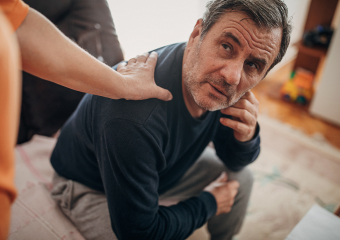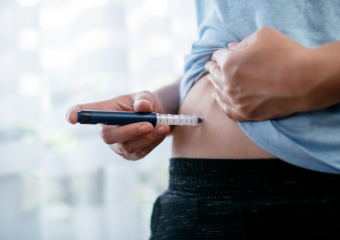Diabetes Ups and Down
There will be times when your blood glucose level can go up or down. Keeping your blood glucose level in your target range is all about finding the right balance. It’s important to be prepared so you know what to do when your blood glucose level is outside your target range and where to get support or help if needed. Let’s start with hyperglycaemia (also known as a hyper).
What's in this page
Managing hyperglycaemia
Causes of hyperglycaemia
There will be times when your blood glucose level isn’t what you expected. If your blood glucose level is above your target range, it is called hyperglycaemia.
Common reasons for hyperglycaemia are when you’re:
- Not getting enough insulin for the carbohydrate (carbs) you’re eating or drinking.
- Missing insulin doses.
- Being sick from an illness or an infection.
- Having surgery or medical procedures.
- Feeling very stressed.
- Not being as active as you usually are.
- Over-treating your low blood glucose levels (hypoglycaemia or hypos for short).
Some other causes of hyperglycaemia
There are many other reasons why your blood glucose levels may be too high, for example:
- Eating too many carbs, unhealthy fats or sweet foods or drinks.
- Using insulin that is out of date or has been accidently frozen.
- Feeling super excited.
- Reacting to a vaccine.
- Other hormones.
- Faulty monitoring equipment, if you are using a continuous glucose monitoring (CGM) or flash glucose monitoring (Flash GM) recheck with a blood glucose meter to confirm hyperglycaemia.
- Sometimes you just don’t know why!
Signs and symptoms of hyperglycaemia
When blood glucose levels are only a little higher than your target range, you may not feel any symptoms. You’ll only know from checking your blood glucose levels. If your blood glucose level continues to rise, you may notice some or all these symptoms.
Passing urine (peeing) more often, especially at night
Feeling very thirsty
Feeling tired and weak
Having Headaches
Having blurry vision
Losing weight
You may remember these symptoms from the time before you were diagnosed with type 1 diabetes.
Reducing risks of hyperglycaemia
If your blood glucose level is high for a short time, you know the reason and if you’re feeling well, treatment may not be necessary. Continue to check your blood glucose level. If you are using CGM or Flash GM, you can set an alarm to alert you to when the glucose is above your target. This can help you track of how you’re going.
Let’s find out what you can do to reduce your risk of hyperglycaemia:
- Check your blood glucose level regularly.
- Choose to use CGM or Flash GM to check your glucose level through the day and night, and set an alarm to alert you when your level is tracking higher.
- Count your carbs to help you work out insulin dose for your meals (bolus insulin).
- Take your insulin and other medication as prescribed by your doctor or nurse practitioner.
- Look for patterns when your blood glucose level is above your target * manage your sleep and stress.
- Have a sick day action plan and start using it as soon as you’re feeling unwell.

Find out more
- Read, listen to or download our CGM, Flash GM and Blood glucose monitoring fact sheets.
If you are using CGM or Flash GM, you may need to confirm your glucose level using a finger prick check with a blood glucose meter.
When to seek medical attention for hyperglycaemia
In most situations you will be able to manage hyperglycaemia at home. Start using your sick day action plan as a guide. Tell a family member or friend, your diabetes health professionals and your family. If there is no improvement, you’re at risk of diabetic ketoacidosis (or DKA for short). DKA is serious if it isn’t treated fast. It’s a medical emergency and you’ll need to go to hospital for treatment. You know your own body and if you feel your symptoms are getting worse, seek emergency medical care.
Try and protect yourself against getting sick. Talk to your diabetes health professionals about vaccines such as the flu injection. Washing your hands and avoiding people who are sick seems simple but is effective in keeping you well.
Some of the warning signs
Your blood glucose level is not improving or the ketones in your blood or urine is increasing
You’re getting drowsy and confused, have signs of dehydration such as a headache, or have severe tummy pain or difficulty breathing
You’ve been vomiting more than 2 hours or can't drink any fluids
The symptoms of your illness aren’t improving with medication such as a high temperature or headache
Exercise tip
Find out more
- Go to Reduce the risk of getting diabetic ketoacidosis.
- Reduce the risk of getting diabetic ketoacidosis) * Read, listen to or download the Living well with type 1 diabetes – what to do when you are sick fact sheet.
- Watch the Living well with type 1 diabetes – what to do when you are sick pre-recorded webinar.
- Go to the Australian Diabetes Educators Association (ADEA) to download an example of a sick day action plan.
Reducing risks of diabetic ketoacidosis
When you have type 1 diabetes and have hyperglycaemia, you’re at risk of DKA. DKA happens when there isn’t enough insulin for the body to use glucose as energy. The body uses fat for energy instead. This makes a build-up of acids in the blood called ketones. If left untreated, the build up of ketones can lead to DKA.
When you have type 1 diabetes, you need to know the warning signs of DKA and when to seek emergency care. Be alert for these serious signs and symptoms and start your sick day action plan immediately.
Signs and symptoms of DKA
Having a fruity-smelling breath
Having nausea, or vomiting and diarrhoea
Having tummy pains
Breathing quickly and deeply, or having trouble catching your breath
Dehydration such as feeling very thirsty, having a dry mouth, or not peeing much
Feeling sleepy, weak or confused
Exercise tips
Your diabetes health professionals will ask you to check for ketones any time your blood glucose level is 15 mmol/L or higher.
Find out more
- Read, listen to or download our CGM, Flash GM and Blood glucose monitoring fact sheets.
Ketones
When to check for ketones
- Your blood glucose level is 15 mmol/L or above.
- You’re sick or feel unwell, even if your blood glucose level is less than 15 mmol/L.
How to check for ketones
Your diabetes health professional will help you decide the best way for you to check for:
- Blood ketones using a compatible blood glucose meter and blood ketone strips OR
- Urine ketones using urine ketone strips (subsidised through the NDSS).
- Drinking water will help reduce the risk of dehydration. Continue to check your blood glucose levels and ketones every 2-4 hours.

If the ketones in your bloodstream are more 0.6 to 1.5 mmol/L (or moderate to high in your urine) start following your sick day action plan. Start straight away to avoid emergency problems like DKA. DKA is best treated with fluids and insulin, usually in hospital.
Managing sick days
Preparing for sick days
Being unwell can make it more challenging to keep blood glucose levels in your target range. This is because of the stress hormones your body releases when you’re sick. Stress hormones increase the amount of glucose the liver releases into the bloodstream.
This can make it difficult for your usual dose of insulin to keep your blood glucose levels in your target range. If you’re sick and have a high blood glucose level, you’re at risk of severe dehydration and getting DKA.
This a medical emergency and left untreated can be life-threatening.
Be prepared and reduce your risks of getting DKA
- Ask your diabetes health professionals to help you make a written diabetes sick day action plan.
- Your doctor, diabetes nurse practitioner or diabetes educator will work with you to develop your personalised plan.
- Work with your diabetes health professionals to update you plan every 1-2 years or more often if there are changes to how you manage your diabetes.
- Keep your plan in an easily accessible place. *Let your family or those who support you know where you keep your plan.

Find out more
- Read, listen to or download our Living well with type 1 diabetes – what to do when you are sick fact sheet.
- Watch our Living well with type 1 diabetes – what to do when you are sick pre-recorded webinar.
- Go to the Australian Diabetes Educators Association for samples of sick day action plans.
Important things to do every time you feel sick

Follow your sick day action plan

Let someone know you are unwell

Check your blood glucose levels more often

Check for ketones

Change your insulin dose if needed

Keep drinking and (if possible) eating

Ask for help

Seek urgent emergency care
It’s a medical emergency and you should go to the hospital emergency department or call 000 immediately if you have blood ketones of 3.0 mmol/L or more, can’t keep food or fluids down, are vomiting a lot or have diarrhoea, don’t have anyone that can help you, you’re not able to follow your sick day action plan.
Ask someone to drive you to the hospital or call 000 for an ambulance.
Your sick day kit
What to pack
